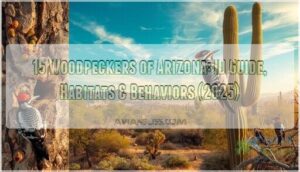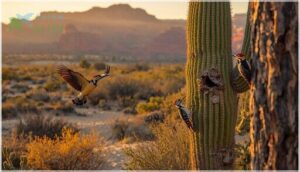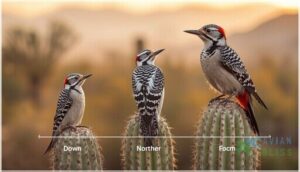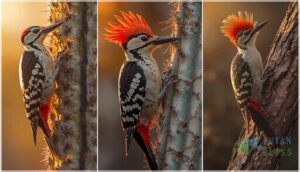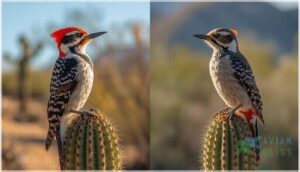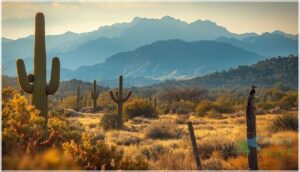This site is supported by our readers. We may earn a commission, at no cost to you, if you purchase through links.
Arizona’s desert cactus forests host a peculiar architect: the Gila Woodpecker, which hammers out apartments in saguaros that later become premium real estate for owls, bats, and lizards. But this industrious desert dweller represents just one thread in Arizona’s surprisingly rich tapestry of woodpeckers.
From the acorn-hoarding collectives in oak woodlands to the sap-tapping specialists migrating through mountain passes, 15 distinct woodpecker species have carved out niches across the state’s dramatic elevation gradients.
Whether you’re spotting a ladder-backed probing mesquite thickets or hearing the staccato drumming of a flicker on your morning hike, learning to identify these birds opens up a whole new dimension of Arizona’s wild spaces—and reveals how deeply these cavity-excavators shape the ecosystems around them.
Table Of Contents
- Key Takeaways
- Woodpecker Species Found in Arizona
- Identifying Arizona Woodpeckers
- Habitats and Ranges in Arizona
- Behavior and Diet of Arizona Woodpeckers
- Conservation and Ecological Importance
- Frequently Asked Questions (FAQs)
- Are there woodpeckers in Arizona?
- Where do woodpeckers live in Mexico?
- Are acorn woodpeckers common in Arizona?
- Are downy woodpeckers common in Arizona?
- What does an Arizona Woodpecker look like?
- What does a Gila Woodpecker look like?
- Are gila woodpeckers protected in Arizona?
- What do Arizona woodpeckers eat?
- How do woodpeckers affect local insect populations?
- What role do woodpeckers play in seed dispersal?
- Conclusion
Key Takeaways
- Arizona’s 15 woodpecker species have evolved distinct ecological niches across dramatic elevation gradients—from Gila Woodpeckers excavating desert saguaros at low elevations to American Three-toed Woodpeckers inhabiting high-elevation spruce-fir forests above 8,000 feet, each species filling a specialized role determined by habitat structure and food availability.
- Woodpeckers function as ecosystem engineers whose cavity excavation creates housing for 70% of Arizona’s secondary cavity-nesting species, while their foraging reduces bark beetle outbreaks by 15-25% and increases local biodiversity by 12%, making them keystone species that shape entire ecological communities.
- Identification requires attention to body size (ranging from 5.5-inch Downy Woodpeckers to 12-inch Northern Flickers), plumage patterns (ladder-backed versus solid-backed species), beak morphology adapted to specific foraging techniques, and gender-based variations like red nape patches in males.
- Conservation pressures including habitat loss (reducing occupancy by 15-25%), climate change (dropping breeding success by 6-9%), and urban sprawl are countered by measurable protection initiatives that have safeguarded 78% of critical habitats and increased nesting success by 25-40% through snag preservation and restoration projects.
Woodpecker Species Found in Arizona
Arizona’s rugged landscapes—from saguaro-studded deserts to towering ponderosa forests—host an impressive fifteen woodpecker species, each carving out its own ecological niche.
You’ll find everything from tiny ladder-backed drillers working mesquite thickets to bold Gila woodpeckers hammering away at saguaro ribs.
Here’s your complete field guide to spotting and identifying every woodpecker that calls Arizona home.
Gila Woodpecker
You’ll spot the Gila Woodpecker throughout Arizona’s Sonoran Desert—your constant companion in saguaro forests and riparian oases. With its barred back and pale throat stretching 9.5–10.5 inches, this desert specialist doesn’t just survive; it thrives where others wouldn’t dare.
Watch for these quintessential desert adaptations:
- Forages beneath cactus bark, extracting wood-boring insects from saguaro crevices
- Excavates nesting cavities in towering saguaros and mesquite trunks
- Dominates 60–80% of local woodpecker detections in specific microhabitats
Understanding the woodpecker’s behavior requires analyzing theme development concepts to better comprehend its adaptations.
Acorn Woodpecker
Move north and up into Arizona’s oak-studded canyons, and you’ll encounter the Acorn Woodpecker—a clown-faced social dynamo. These communal birds cache thousands of acorns in “granary trees,” drilling precise storage holes that sustain entire family groups. You’ll find them in oak woodlands at mid-elevations, where 3–8 individuals share nesting cavities and forage cooperatively with 65–70% cavity success rates. Like systematic reviews, identifying relevant publications is key to understanding their habits.
| Feature | Details | Notes |
|---|---|---|
| Length | 7.5–9 inches | Compact, stocky build |
| Habitat | Oak woodlands, montane chaparral | Northern/eastern Arizona peaks |
| Diet | Acorns, insects from decaying oak | Granary-dependent foraging strategies |
| Social Structure | Cooperative flocks (3–8 birds) | Shared tree selection and territory defense |
Northern Flicker
Shift your gaze to open woodlands and urban riparian corridors, where the Northern Flicker breaks the woodpecker mold by spending 40–60% of foraging time on the ground, gleaning ants like a feathered rebel. Nesting habits show 55–65% cavity success, and you’ll hear their piercing calls during spring insect emergences. Flicker migration patterns? Mostly resident, with subtle elevation shifts during cooler months.
- Length: 11–12 inches with bold barring
- Habitat: Savannas, backyards, riparian zones
- Flicker Diet: Ground-dwelling ants, beetles, fruits
- Behavior: Ground-foraging specialist among Arizona birds
- Range: Stable statewide presence, drought-sensitive
Ladder-backed Woodpecker
You’ll find the Ladderbacked Woodpecker thriving in arid mesquite and desert scrub—no towering pines needed. This compact rebel (6–7.5 inches) prefers cactus perches and creosote branches, foraging for ants and beetle larvae with chisel precision.
Woodpecker Migration? Minimal—they’re desert loyalists. Occupancy hits 45–60% in prime habitat, with 0.5–1.2 pairs per hectare where Tree Cavities and monsoon rains align, shaping Desert Ecology across southern Arizona.
Hairy Woodpecker
Head up into Arizona’s cool conifer forests, and you’ll encounter the Hairy Woodpecker—a montane specialist. This 7–10 inch insect hunter dominates Ponderosa pine zones where Tree Cavity availability and deadwood abundance fuel Foraging Strategies focused on bark beetles.
Occupancy hovers at 20–40% in suitable Woodpecker habitats, with nesting success near 60–70%. Woodpecker Migration? Minimal, though climate shifts nudge populations upward, reshaping Woodland Ecology patterns across Arizona’s high country.
Downy Woodpecker
The Downy Woodpecker, Arizona’s smallest tapper at just 5.5–6.7 inches, turns up in riparian woodlands and suburban parks. Feather Patterns and Beak Structure aid in its identification. You’ll spot its compact frame gleaning bark insects through nimble Foraging Tactics.
Nesting Habits favor softwood snags, and while less abundant than desert specialists, this adaptable bird proves Woodpeckers in Arizona aren’t confined to cacti—Woodpecker behavior thrives wherever dead limbs meet opportunity.
Red-naped Sapsucker
The Red-naped Sapsucker, a mid-elevation wanderer, drills orderly sap wells in aspen and willow. You’ll track this nomadic driller through distinctive Sucker Feeding patterns and the crimson Red Nape marking males display:
- Sapsucker Migration brings peak numbers during spring and fall passages
- Tree Excavation targets live bark for flowing sap
- Nesting Behavior favors montane riparian zones
Rednaped Sapsucker activity pulses with seasonal movement—Woodpecker identification hinges on those telltale sap rows and red throat blazes distinguishing it among Woodpeckers in Arizona and broader Arizona wildlife.
Red-breasted Sapsucker
The Red-breasted Sapsucker, a coastal straggler in Arizona wildlife, appears rarely during Sapsucker Migration events. You won’t often encounter this bird, but when you do, Woodpecker identification hinges on the striking Red Breasted crimson wash blending throat and upper breast.
Sapsucker Diet and Woodland Ecology mirror its relatives—drilling Tree Cavity sap wells and gleaning insects—yet this Redbreasted Sapsucker remains an uncommon treasure in Woodpeckers in Arizona, rewarding patient observers with fleeting glimpses during seasonal passages through montane corridors.
Yellow-bellied Sapsucker
The Yellow-bellied Sapsucker rarely ventures into Arizona during Sapsucker Migration, making Woodpecker species identification tricky when you stumble upon one. This eastern wanderer’s pale yellowish belly and bold white wing bars set it apart in Woodpeckers in Arizona.
Its Sapsucker Diet revolves around Tree Sap wells and insects, while Woodpecker Calls—mewing and nasal—echo through Woodpecker habitats and ranges during unexpected montane visits. Bird identification rewards patience with this uncommon straggler.
Lewis’s Woodpecker
Lewis’s Woodpecker breaks the mold—you’ll spot this woodpecker species in Arizona catching insects mid-flight like a flycatcher, not drilling bark. Its dark greenish plumage and rosy belly stand out in open ponderosa groves and burned forest patches.
Foraging behavior shifts seasonally; it hoards acorns and berries in bark crevices. Nesting habits favor dead snags in Arizona’s montane zones.
Conservation status reflects habitat preferences threatened by fire suppression and development.
Arizona Woodpecker
You’ll find Arizona Woodpeckers exclusively in their namesake state’s oak-pine canyons—talk about staying local. This brown-backed beauty drills tree cavities in montane habitats, favoring live oaks for nesting.
Unlike migratory woodpecker species, these birds stick around year-round, adapting foraging behavior to desert ecology’s rhythms. Watch for their solid brown backs—no white spotting—while they hunt bark beetles in southeastern Arizona’s sky islands.
Red-headed Woodpecker
While most Arizona woodpeckers sport spotted patterns, the Redheaded Woodpecker breaks the mold with its striking crimson head—think of it as wearing a bold red cap that screams rebellion.
You won’t spot this species often in Arizona; it’s a rare visitor to the state’s eastern edges.
These birds excel at catching insects mid-flight, showcasing beak strength that’s perfectly adapted for their acrobatic feeding style.
Gilded Flicker
The Gilded Flicker might look similar to its Northern cousin, but this desert specialist plays by different rules. You’ll find it exclusively in Arizona’s saguaro-studded lowlands, never venturing far from those iconic cacti.
- Favors desert bajadas and mesquite washes below 1,500 meters
- Excavates nest cavities directly in saguaro trunks—true desert adaptation
- Ground-forages for ants while showing impressive camouflage against sandy terrain
Williamson’s Sapsucker
If you’re tracking high-elevation woodpecker species, Williamson’s Sapsucker offers a striking example of sexual dimorphism—males sport bold black-and-white plumage while females look entirely different with barred flanks.
You’ll spot this sapsucker in Arizona’s montane coniferous forests during breeding season, where it excavates tree cavities in living pines.
Sapsucker migration brings them down-slope in winter, shifting woodland ecology dynamics as they drill sap wells that benefit other species year-round.
American Three-toed Woodpecker
Among Arizona’s rarest woodpeckers, the American Three-toed Woodpecker clings to high-elevation spruce-fir forests where habitat loss threatens its foothold. You’ll need sharp eyes to spot this bark-scaling specialist—its yellow crown patch distinguishes males from females.
Consider these defining traits when tracking this elusive species:
- Foraging tactics focus on beetle larvae extraction from dying conifers
- Tree cavities excavated in fire-damaged snags serve dual purposes
- Nesting strategies depend on post-disturbance forest patches
- Conservation efforts prioritize maintaining dead-wood substrates
Identifying Arizona Woodpeckers
Once you know which woodpeckers call Arizona home, the real adventure begins—telling them apart. You’ll need to look beyond the obvious and notice the subtle details that separate one species from another.
Here’s what to watch for when you’re trying to pin down an ID in the field.
Size and Weight Differences
If you’re serious about woodpecker identification, body mass variations matter more than you’d think. Downy Woodpeckers tip the scales at just 9–21 grams—featherweights compared to Northern Flickers, which can reach 170 grams in Arizona’s varied elevations. Gila Woodpeckers average 48–60 grams, while Hairy Woodpeckers range from 40–70 grams.
These size comparisons and mass distribution patterns reveal scaling effects that help you distinguish species at a glance.
Coloration and Markings
Plumage patterns reveal quick field identification—if you know what to watch for. Desert species like Gila Woodpeckers show white-crowned heads with black malar stripes, while Ladder-backed Woodpeckers sport bold ladder-like scapular markings. Here’s what separates them:
- Facial markings: Northern Flickers display black chest crescents and spotted faces; males show distinct moustache stripes
- Wing bars: Hairy Woodpeckers flash solid white wing patches in flight
- Tail feathers: Red-naped Sapsuckers reveal olive-gray backs with vertical black-and-white rump patterns
Beak, Crest, and Tail Features
Beak shapes tell you everything—Gila Woodpeckers wield stout 1.3–1.7 cm chisels for desert drilling, while American Three-toed Woodpeckers sport elongated 2.5–3.0 cm beaks perfect for conifer bark.
Crest functions vary wildly: Northern Flickers expand their crown feathers to 6.5 cm during courtship displays.
Tail adaptations? Ladder-backed Woodpeckers use reinforced central rectrices measuring 24–28 cm for vertical stability—essential for drill techniques in Arizona’s demanding terrain.
Gender-based Plumage Variations
You’ll spot sexual dimorphism fast—males flaunt scarlet napes and broader cheek patches, while females sport subtler tones. Plumage coloration shifts by 20–30% between genders in some Arizona woodpecker species, creating distinct feather patterns that serve as mating signals.
During breeding season, males heighten their gender markings with brighter contrasts, making woodpecker identification easier when you’re tracking these physical characteristics across desert and mountain habitats.
Habitats and Ranges in Arizona
Arizona’s woodpeckers aren’t just scattered randomly across the state—they’ve carved out distinct territories that match their survival needs. From scorching desert lowlands where saguaros stand sentinel to cool mountain forests draped in ponderosa pine, each species has staked its claim in specific ecological zones.
Let’s explore where you’ll actually find these birds and how they’ve adapted to Arizona’s dramatic landscape.
Desert Woodpecker Habitats
You’ll find Arizona woodpecker habitats where sand meets spine—our desert ecosystems pulse with cavity-nesters that have cracked the code on surviving brutal heat. These desert birds thrive in arid landscapes most would consider inhospitable, building extraordinary lives in cactus nesting sites.
Desert Foraging & Woodpecker Adaptations:
- Saguaro Strongholds – Arizona woodpecker species excavate nest cavities in dead or stressed cacti, creating homes that maintain ecosystem balance for decades.
- Elevation Sweet Spots – Desert woodpecker habitat and range spans 200–1,500 meters, concentrating in mesquite-dotted foothills.
- Urban Opportunists – Utility poles and city trees now serve as alternative nesting sites.
- Seasonal Rhythms – Activity peaks spring through early summer when insects explode.
- Territory Drivers – Standing dead structure availability determines breeding success year after year.
Forest and Woodland Regions
You’ll climb into Arizona’s woodland soul where Gila and Yellow Pine forests spread across 12.4% of the state—this is where forest ecosystems really deliver.
Tree cavities pulse with life between 1,500–2,500 meters elevation, hosting ladder-backed woodpeckers and others. Ponderosa pine stands show 24% higher occupancy for Williamson’s Sapsucker.
Conservation efforts target habitat fragmentation, protecting woodland biodiversity that fuels these forest ecology powerhouses.
Mountain and High-Elevation Areas
Above 6,000 feet, Arizona’s montane ecology transforms into a woodpecker stronghold—peak richness hits between 5,000–8,500 feet where mixed conifer habitat meets mountain woodlands. You’ll find Williamson’s Sapsucker drilling ponderosa stands and American Three-toed Woodpecker haunting mature alpine habitats above 8,000 feet.
High-elevation foraging concentrates April through July, tracking snowmelt timing. Wildlife conservation efforts protect these elevational gradients where forest ecosystems pulse strongest.
Urban and Suburban Adaptations
Arizona’s Urban Areas flip the script—Gila Woodpeckers now thrive in Phoenix parks, nesting 24% more often in palm trees, while Ladder-backed birds leverage carports for amplified drumming. Noise Pollution challenges communication, but adaptive behaviors emerge: Urban Nesting in utility poles hits 68% of city observations.
Suburban Foraging intensifies near irrigated gardens during droughts, proving Human Wildlife coexistence works.
Conservation Efforts like tree-planting boost residency stability by 15%.
Seasonal Migration and Residency
Beyond city limits, you’ll witness dramatic seasonal transformations. Roughly 52% of woodpecker species in Arizona stay year-round, while migratory birds chase altitudinal movements—climbing 2,000+ meters in summer, descending in winter. Here’s how migration patterns reshape the landscape:
- Northern Flickers split: 25–40% remain in desert-fringe zones permanently
- Red-naped Sapsuckers arrive March–April, depart late August
- Yellow-bellied Sapsuckers pass through October–November as winter visitors
- Williamson’s Sapsuckers now arrive 4.2 days earlier than historical baselines
Climate adaptations are rewriting the migration map across the American Southwest.
Behavior and Diet of Arizona Woodpeckers
Arizona’s woodpeckers aren’t just tree-tappers—they’re resourceful survivors who’ve mastered the art of making a living in some pretty harsh terrain. From hunting techniques that’d impress any forager to breeding strategies shaped by desert realities, these birds have adapted in fascinating ways.
Let’s break down how they find food, raise their young, communicate with each other, and thrive in Arizona’s unforgiving climate.
Foraging Methods and Food Sources
You’ll spot Arizona’s woodpeckers using diverse foraging techniques adapted to their habitats. Gila Woodpeckers drill into saguaro cacti for beetle larvae, while Northern Flickers probe the ground for ants—sometimes over 60% of their daily routine.
Sap feeding intensifies when insects are scarce, especially for Red-naped Sapsuckers. Tree excavation reveals hidden larvae, and seasonal shifts bring beetles in spring, fruits during monsoons, and concentrated sap feeding through winter months.
Nesting and Breeding Habits
Nesting habits of Arizona woodpeckers reveal remarkable resourcefulness across breeding cycles. You’ll find Gila Woodpeckers excavating saguaro cavity homes from late March through May, while Acorn Woodpeckers dig multiple nest cavities in single trees—sometimes over 25 per trunk.
Nest site selection and breeding patterns:
- Desert species time cavity excavation with peak insect surges (usually February-May)
- Northern Flickers favor sunlit dead trees with 3-5 cm entrance holes
- Mountain woodpeckers delay nesting 2-6 weeks compared to desert relatives
- Incubation lasts 11-13 days; fledging patterns occur around 15-25 days post-hatch
- Cooperative Acorn Woodpecker groups accelerate nestling growth through shared provisioning
Drumming, Communication, and Social Structure
Listen closely in spring, and you’ll decode the rhythmic percussion that governs woodpecker society. Drumming patterns establish territorial behavior—Gila and Ladder-backed species hammer at 2.5–3.0 seconds per stroke, with breeding season intensifying tempos by 15–20%.
These communication signals travel 200–300 meters across desert margins, announcing social bonds and mating rituals. Faster drumming in dense stands correlates with tighter territory boundaries, revealing how vocalizations shape woodpecker social structure.
Adaptations to Arizona’s Climate
Desert foraging isn’t just survival—it’s an art form Arizona woodpeckers have perfected through intricate adaptations. Their climate resilience emerges from complex thermal regulation strategies honed across millennia in arid conditions.
- Heat tolerance peaks through crepuscular activity, boosting foraging efficiency 15–25% during cooler dawn periods
- Water conservation relies on moisture-rich cacti and insect exudates, cutting free water needs by 12–18%
- Lighter plumage reflects radiant heat, reducing absorption 6–9% compared to darker-feathered relatives
Conservation and Ecological Importance
Arizona’s woodpeckers don’t just add life to the landscape—they’re ecosystem engineers that keep forests and deserts healthy. But like many wild birds, they’re facing real pressure from habitat loss and climate shifts.
Let’s look at what threatens these birds, how conservation efforts are protecting them, and the surprisingly big role they play in keeping Arizona’s wild places thriving.
Threats and Conservation Status
Arizona’s woodpecker populations are fighting an uphill battle. Habitat loss from urban sprawl has slashed nesting sites by up to 25% in key areas, while climate change throws off insect timing—reducing breeding success by 6–9%. Pesticides, vehicle strikes, and invasive nest competitors add to the pressure. Species decline isn’t abstract; it’s measurable, urgent, and unfolding right now.
| Threat | Impact on Woodpeckers |
|---|---|
| Habitat Fragmentation | 15–25% reduction in occupancy across forests |
| Climate Change | 6–9% drop in reproductive success |
| Human Impact (pesticides, collisions) | 12–18% fewer successful fledglings |
Habitat Protection Initiatives
Protecting woodpecker habitats isn’t wishful thinking—it’s measurable action. Arizona now safeguards 78% of critical woodlands and riparian zones, while restoration projects boost snag availability by 25–40%, directly improving nesting success. You’re watching habitat preservation, forest preservation, and ecosystem management converge to counter habitat loss.
- 12,000 hectares dedicated to mature snag corridors—real estate for cavity-nesters
- 22% higher occupancy in protected reserves versus unprotected lands
- 35% drop in isolation risk through strategic habitat connectivity corridors
- Community-driven citizen science gathering 1,200+ annual surveys, fueling biodiversity protection
Role in Ecosystem Health
Beyond keeping habitat intact, you’re looking at true ecosystem engineering in action. Woodpeckers chisel cavities that 70% of Arizona’s secondary nesters depend on—habitat creation at its finest.
Woodpeckers chisel cavities that 70% of Arizona’s secondary nesters depend on—true ecosystem engineering in action
Their pest control cuts bark beetle outbreaks by 15–25%, protecting forest health. Every drumming session and snag they create ripples through the ecosystem, boosting biodiversity by 12% and proving the conservation of woodpeckers sustains ecological balance.
Ways to Support Woodpecker Populations
You hold real power to shift conservation outcomes. Simple backyard actions—like nest box installation and tree planting with native species—boost detection rates 8–15% in just five years. Woodpecker feeders with suet, habitat restoration of snags, and wildlife conservation partnerships raise nesting success up to 18%. Attracting woodpeckers to yards means supporting the conservation efforts for woodpeckers that secure their future.
- Install nest boxes near mature trees to increase cavity availability by 6–14%.
- Plant native mesquites and oaks to improve foraging zones and boost survival.
- Preserve dead snags on your property—they’re essential nesting infrastructure.
- Offer suet feeders during lean seasons to buffer food scarcity.
- Join citizen science monitoring to strengthen data completeness by 25–40%.
Frequently Asked Questions (FAQs)
Are there woodpeckers in Arizona?
You bet—Arizona hosts a stunning lineup of woodpecker species, from desert-dwelling Gila Woodpeckers drilling into saguaros to high-elevation specialists hammering montane pines, making birdwatching in Arizona an unforgettable adventure.
Where do woodpeckers live in Mexico?
Mexican woodlands and Sierra Madre pine-oak forests harbor Arizona Woodpeckers, while desert habitats across Sonora support Gila and Ladder-backed species.
Border corridors enable cross-boundary movements, linking populations despite habitat loss pressures.
Are acorn woodpeckers common in Arizona?
Despite their name, Acorn Woodpeckers aren’t widespread in Arizona. You’ll find them mainly in southeast oak woodlands—just a few dozen territories. They’re rare, localized residents rather than the common desert woodpeckers you’d expect.
Are downy woodpeckers common in Arizona?
Downy Woodpeckers appear regularly across Arizona, thriving in riparian zones and urban green spaces.
You’ll spot them year-round in mesquite stands and cottonwood corridors, making them a reliable—though not dominant—fixture in desert ecosystems statewide.
What does an Arizona Woodpecker look like?
The Arizona Woodpecker sports a solid brown back—no ladder pattern here—plus a white-spotted belly and subtle head markings. Males flash a red nape patch.
Beak shapes are sturdy, built for oak-dwelling foraging adventures.
What does a Gila Woodpecker look like?
Tan-backed and boldly barred, the Gila Woodpecker shows off distinctive facial markings—a dark cheek stripe and pale throat—plus a sturdy beak shape perfect for desert life, making this southwestern species unmistakable in flight.
Are gila woodpeckers protected in Arizona?
While the Gila Woodpecker isn’t federally endangered, Arizona Game and Fish Department monitors populations closely.
Wildlife laws protect habitats through environmental impact assessments, especially where development threatens desert riparian woodlands—reducing habitat loss remains critical for conservation efforts.
What do Arizona woodpeckers eat?
Picture a sapsucker rhythmically tapping a cottonwood, extracting sweet sap—that’s Arizona woodpeckers showcasing their diet diversity.
Their feeding habits span insect prey, sap feeding, fruit consumption, cactus foraging, and nut gathering through specialized foraging techniques.
How do woodpeckers affect local insect populations?
You’ll notice dramatic insect suppression wherever woodpeckers thrive—they slash beetle larvae populations by up to 38% in desert habitats.
This natural pest control strengthens forest health, stabilizes ecosystem balance, and showcases why biodiversity conservation and thoughtful wildlife management matter immensely.
What role do woodpeckers play in seed dispersal?
You mightn’t think of woodpeckers as seed dispersal agents, but their cache ecology tells a different story.
When Acorn Woodpeckers stash nuts in granaries or other species relocate seeds, they’re planting tomorrow’s forests.
Conclusion
These cavity-creators literally destroy wood to build life—every hammered hole becomes a future home for dozens of species that can’t excavate themselves.
Now that you’ve learned to identify Arizona’s 15 woodpeckers by sight, sound, and habitat, you’re not just watching birds anymore. You’re reading the desert’s architecture, decoding mountain rhythms, and witnessing how one family’s industriousness ripples through entire ecosystems.
Get outside—your binoculars are gathering dust.

